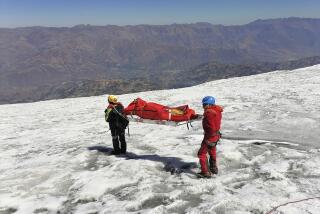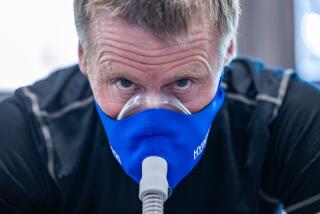‘Meru’ tackles not just a summit, but deep bond between mountain climbers
- Share via
When asked why they are compelled to climb dangerous mountains such as Mt. Everest, neither Conrad Anker nor Jimmy Chin mentions fame or glory. They talk about the passion and friendship of the sport.
Mountain climbing, Chin noted, “is the right combination of being in the mountains, the friendship you create out of it and your personal experience — physically and intellectually. Those things combined make it something that I am in love with.”
Anker, who discovered the body of explorer George Mallory, missing since 1924, when he climbed Everest in 1999, said “when you find your passion, it’s great. You go up a mountain with partners, and you have a wonderful opportunity to connect and achieve a goal together. You are not trying to be better than other humans. You are supporting each other.”
SIGN UP for the free Indie Focus movies newsletter >>
That friendship is at the center of the award-winning documentary “Meru,” which opens Friday. Directed by Chin, 41, and his wife, Elizabeth Chai Vasarhelyi, “Meru” explores the two expeditions that Chin, Anker and Renan Ozturk made in 2008 and in 2011 to Mt. Meru in northern India.
The three Americans were attempting what no experienced alpine climber had ever achieved: to reach the top of Meru’s Shark’s Fin, which sits 21,000 feet above the Ganges River. Unlike most Everest climbers, the three had no Sherpas helping them carry their gear up the dangerous peak.
They brought only enough food and fuel for seven days in their first attempt, but because they were waylaid by a snowstorm, the climb lasted 20 days. They had to turn around before they made it to the summit. Despite Ozturk suffering a traumatic head injury skiing in the backcountry of the Grand Tetons, they regrouped in 2011 to make another attempt.
“We all connected together to support him,” said Anker of Ozturk. “That helped in his healing process, and we had trust in his ability and strength.”
Anker noted that “there are plenty of climbing movies out there with great climbing action in them. They are for specialty audiences.”
But “Meru” is different, said Anker, 52. “This is a movie about Renan, Jimmy and myself and our interaction with our families. It gives you the idea of the depths that climbing brings to the people who practice it.”
Though Chin had never directed a feature documentary before, he has been photographing and filming expeditions and athletes for the past 15 years. “In 2008, I was filming with Renan — more for posterity in all honesty. When we came back from [the climb] in 2011, I thought maybe we had something.”
It was paramount for him and Ozturk, 35, not to “let the production have an impact on the climbing. You are trying to balance this juggling act of shooting as much as you can, but also being judicious with your shooting because you don’t have unlimited power.
Equally important, said Chin: “Don’t drop the camera.”
Chin met Vasarhelyi at a conference. The two fell in love while making the film and are now married and have a 2-year-old daughter.
“Chai came in and brought that objective point of view because I was really close to the film, obviously,” said Chin. “It really was an incredible collaboration with her because she saw things I didn’t see. In my first couple of cuts, I didn’t put myself much in the film. I was the filmmaker and wasn’t comfortable being in the film. “
Because she is a non-climber, Vasarhelyi noted that “for an outsider it’s really hard to understand the stakes or the context of what they are doing. The story of friendship is at the heart of the film, and it was essential to bring that to life, as well as the stories of the people who support them in terms of helping people understand that these guys aren’t really crazy.
“They are passionate. It is very sophisticated what they do and the stakes are very high.”
More to Read
Only good movies
Get the Indie Focus newsletter, Mark Olsen's weekly guide to the world of cinema.
You may occasionally receive promotional content from the Los Angeles Times.









